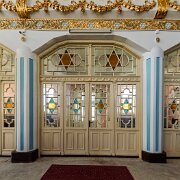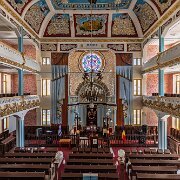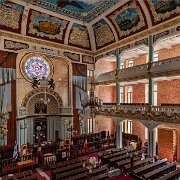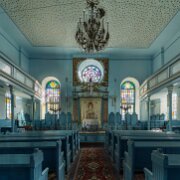
1 Sinagoga Galați, located in the city of Galați, Romania, is one of the last remaining Jewish places of worship in a city that once had a thriving Jewish community. Galați was an important port and trade center in the 19th and early 20th centuries, attracting a significant Jewish population that contributed to the city's economic and cultural life. At its peak, Galați had multiple synagogues, but many were either destroyed or abandoned due to waves of emigration and historical events such as World War II and the communist regime's policies. Today, Sinagoga Galați stands as a testament to the city's Jewish heritage, serving both as a place of worship and a historical monument preserving the legacy of the community.
Architecturally, Sinagoga Galați reflects a blend of Moorish, Neo-Gothic, and Romanian influences, common in Eastern European synagogues of the 19th and early 20th centuries. The building features an elegant façade with arched windows, decorative brickwork, and ornate detailing that highlight its historical significance. Inside, the synagogue houses a richly decorated aron kodesh (holy ark) and intricate wooden carvings, alongside traditional Jewish symbols. Though much of Galați’s Jewish community has diminished, efforts have been made to restore and maintain the synagogue, ensuring that its architectural beauty and historical importance remain preserved for future generations.
Architecturally, Sinagoga Galați reflects a blend of Moorish, Neo-Gothic, and Romanian influences, common in Eastern European synagogues of the 19th and early 20th centuries. The building features an elegant façade with arched windows, decorative brickwork, and ornate detailing that highlight its historical significance. Inside, the synagogue houses a richly decorated aron kodesh (holy ark) and intricate wooden carvings, alongside traditional Jewish symbols. Though much of Galați’s Jewish community has diminished, efforts have been made to restore and maintain the synagogue, ensuring that its architectural beauty and historical importance remain preserved for future generations.

2 Sinagoga Galați, located in the city of Galați, Romania, is one of the last remaining Jewish places of worship in a city that once had a thriving Jewish community. Galați was an important port and trade center in the 19th and early 20th centuries, attracting a significant Jewish population that contributed to the city's economic and cultural life. At its peak, Galați had multiple synagogues, but many were either destroyed or abandoned due to waves of emigration and historical events such as World War II and the communist regime's policies. Today, Sinagoga Galați stands as a testament to the city's Jewish heritage, serving both as a place of worship and a historical monument preserving the legacy of the community.
Architecturally, Sinagoga Galați reflects a blend of Moorish, Neo-Gothic, and Romanian influences, common in Eastern European synagogues of the 19th and early 20th centuries. The building features an elegant façade with arched windows, decorative brickwork, and ornate detailing that highlight its historical significance. Inside, the synagogue houses a richly decorated aron kodesh (holy ark) and intricate wooden carvings, alongside traditional Jewish symbols. Though much of Galați’s Jewish community has diminished, efforts have been made to restore and maintain the synagogue, ensuring that its architectural beauty and historical importance remain preserved for future generations.
Architecturally, Sinagoga Galați reflects a blend of Moorish, Neo-Gothic, and Romanian influences, common in Eastern European synagogues of the 19th and early 20th centuries. The building features an elegant façade with arched windows, decorative brickwork, and ornate detailing that highlight its historical significance. Inside, the synagogue houses a richly decorated aron kodesh (holy ark) and intricate wooden carvings, alongside traditional Jewish symbols. Though much of Galați’s Jewish community has diminished, efforts have been made to restore and maintain the synagogue, ensuring that its architectural beauty and historical importance remain preserved for future generations.

3 Sinagoga Galați, located in the city of Galați, Romania, is one of the last remaining Jewish places of worship in a city that once had a thriving Jewish community. Galați was an important port and trade center in the 19th and early 20th centuries, attracting a significant Jewish population that contributed to the city's economic and cultural life. At its peak, Galați had multiple synagogues, but many were either destroyed or abandoned due to waves of emigration and historical events such as World War II and the communist regime's policies. Today, Sinagoga Galați stands as a testament to the city's Jewish heritage, serving both as a place of worship and a historical monument preserving the legacy of the community.
Architecturally, Sinagoga Galați reflects a blend of Moorish, Neo-Gothic, and Romanian influences, common in Eastern European synagogues of the 19th and early 20th centuries. The building features an elegant façade with arched windows, decorative brickwork, and ornate detailing that highlight its historical significance. Inside, the synagogue houses a richly decorated aron kodesh (holy ark) and intricate wooden carvings, alongside traditional Jewish symbols. Though much of Galați’s Jewish community has diminished, efforts have been made to restore and maintain the synagogue, ensuring that its architectural beauty and historical importance remain preserved for future generations.
Architecturally, Sinagoga Galați reflects a blend of Moorish, Neo-Gothic, and Romanian influences, common in Eastern European synagogues of the 19th and early 20th centuries. The building features an elegant façade with arched windows, decorative brickwork, and ornate detailing that highlight its historical significance. Inside, the synagogue houses a richly decorated aron kodesh (holy ark) and intricate wooden carvings, alongside traditional Jewish symbols. Though much of Galați’s Jewish community has diminished, efforts have been made to restore and maintain the synagogue, ensuring that its architectural beauty and historical importance remain preserved for future generations.

4 Sinagoga Galați, located in the city of Galați, Romania, is one of the last remaining Jewish places of worship in a city that once had a thriving Jewish community. Galați was an important port and trade center in the 19th and early 20th centuries, attracting a significant Jewish population that contributed to the city's economic and cultural life. At its peak, Galați had multiple synagogues, but many were either destroyed or abandoned due to waves of emigration and historical events such as World War II and the communist regime's policies. Today, Sinagoga Galați stands as a testament to the city's Jewish heritage, serving both as a place of worship and a historical monument preserving the legacy of the community.
Architecturally, Sinagoga Galați reflects a blend of Moorish, Neo-Gothic, and Romanian influences, common in Eastern European synagogues of the 19th and early 20th centuries. The building features an elegant façade with arched windows, decorative brickwork, and ornate detailing that highlight its historical significance. Inside, the synagogue houses a richly decorated aron kodesh (holy ark) and intricate wooden carvings, alongside traditional Jewish symbols. Though much of Galați’s Jewish community has diminished, efforts have been made to restore and maintain the synagogue, ensuring that its architectural beauty and historical importance remain preserved for future generations.
Architecturally, Sinagoga Galați reflects a blend of Moorish, Neo-Gothic, and Romanian influences, common in Eastern European synagogues of the 19th and early 20th centuries. The building features an elegant façade with arched windows, decorative brickwork, and ornate detailing that highlight its historical significance. Inside, the synagogue houses a richly decorated aron kodesh (holy ark) and intricate wooden carvings, alongside traditional Jewish symbols. Though much of Galați’s Jewish community has diminished, efforts have been made to restore and maintain the synagogue, ensuring that its architectural beauty and historical importance remain preserved for future generations.

5 Sinagoga Galați, located in the city of Galați, Romania, is one of the last remaining Jewish places of worship in a city that once had a thriving Jewish community. Galați was an important port and trade center in the 19th and early 20th centuries, attracting a significant Jewish population that contributed to the city's economic and cultural life. At its peak, Galați had multiple synagogues, but many were either destroyed or abandoned due to waves of emigration and historical events such as World War II and the communist regime's policies. Today, Sinagoga Galați stands as a testament to the city's Jewish heritage, serving both as a place of worship and a historical monument preserving the legacy of the community.
Architecturally, Sinagoga Galați reflects a blend of Moorish, Neo-Gothic, and Romanian influences, common in Eastern European synagogues of the 19th and early 20th centuries. The building features an elegant façade with arched windows, decorative brickwork, and ornate detailing that highlight its historical significance. Inside, the synagogue houses a richly decorated aron kodesh (holy ark) and intricate wooden carvings, alongside traditional Jewish symbols. Though much of Galați’s Jewish community has diminished, efforts have been made to restore and maintain the synagogue, ensuring that its architectural beauty and historical importance remain preserved for future generations.
Architecturally, Sinagoga Galați reflects a blend of Moorish, Neo-Gothic, and Romanian influences, common in Eastern European synagogues of the 19th and early 20th centuries. The building features an elegant façade with arched windows, decorative brickwork, and ornate detailing that highlight its historical significance. Inside, the synagogue houses a richly decorated aron kodesh (holy ark) and intricate wooden carvings, alongside traditional Jewish symbols. Though much of Galați’s Jewish community has diminished, efforts have been made to restore and maintain the synagogue, ensuring that its architectural beauty and historical importance remain preserved for future generations.

6 Sinagoga Galați, located in the city of Galați, Romania, is one of the last remaining Jewish places of worship in a city that once had a thriving Jewish community. Galați was an important port and trade center in the 19th and early 20th centuries, attracting a significant Jewish population that contributed to the city's economic and cultural life. At its peak, Galați had multiple synagogues, but many were either destroyed or abandoned due to waves of emigration and historical events such as World War II and the communist regime's policies. Today, Sinagoga Galați stands as a testament to the city's Jewish heritage, serving both as a place of worship and a historical monument preserving the legacy of the community.
Architecturally, Sinagoga Galați reflects a blend of Moorish, Neo-Gothic, and Romanian influences, common in Eastern European synagogues of the 19th and early 20th centuries. The building features an elegant façade with arched windows, decorative brickwork, and ornate detailing that highlight its historical significance. Inside, the synagogue houses a richly decorated aron kodesh (holy ark) and intricate wooden carvings, alongside traditional Jewish symbols. Though much of Galați’s Jewish community has diminished, efforts have been made to restore and maintain the synagogue, ensuring that its architectural beauty and historical importance remain preserved for future generations.
Architecturally, Sinagoga Galați reflects a blend of Moorish, Neo-Gothic, and Romanian influences, common in Eastern European synagogues of the 19th and early 20th centuries. The building features an elegant façade with arched windows, decorative brickwork, and ornate detailing that highlight its historical significance. Inside, the synagogue houses a richly decorated aron kodesh (holy ark) and intricate wooden carvings, alongside traditional Jewish symbols. Though much of Galați’s Jewish community has diminished, efforts have been made to restore and maintain the synagogue, ensuring that its architectural beauty and historical importance remain preserved for future generations.

7 Sinagoga Galați, located in the city of Galați, Romania, is one of the last remaining Jewish places of worship in a city that once had a thriving Jewish community. Galați was an important port and trade center in the 19th and early 20th centuries, attracting a significant Jewish population that contributed to the city's economic and cultural life. At its peak, Galați had multiple synagogues, but many were either destroyed or abandoned due to waves of emigration and historical events such as World War II and the communist regime's policies. Today, Sinagoga Galați stands as a testament to the city's Jewish heritage, serving both as a place of worship and a historical monument preserving the legacy of the community.
Architecturally, Sinagoga Galați reflects a blend of Moorish, Neo-Gothic, and Romanian influences, common in Eastern European synagogues of the 19th and early 20th centuries. The building features an elegant façade with arched windows, decorative brickwork, and ornate detailing that highlight its historical significance. Inside, the synagogue houses a richly decorated aron kodesh (holy ark) and intricate wooden carvings, alongside traditional Jewish symbols. Though much of Galați’s Jewish community has diminished, efforts have been made to restore and maintain the synagogue, ensuring that its architectural beauty and historical importance remain preserved for future generations.
Architecturally, Sinagoga Galați reflects a blend of Moorish, Neo-Gothic, and Romanian influences, common in Eastern European synagogues of the 19th and early 20th centuries. The building features an elegant façade with arched windows, decorative brickwork, and ornate detailing that highlight its historical significance. Inside, the synagogue houses a richly decorated aron kodesh (holy ark) and intricate wooden carvings, alongside traditional Jewish symbols. Though much of Galați’s Jewish community has diminished, efforts have been made to restore and maintain the synagogue, ensuring that its architectural beauty and historical importance remain preserved for future generations.

8 Sinagoga Galați, located in the city of Galați, Romania, is one of the last remaining Jewish places of worship in a city that once had a thriving Jewish community. Galați was an important port and trade center in the 19th and early 20th centuries, attracting a significant Jewish population that contributed to the city's economic and cultural life. At its peak, Galați had multiple synagogues, but many were either destroyed or abandoned due to waves of emigration and historical events such as World War II and the communist regime's policies. Today, Sinagoga Galați stands as a testament to the city's Jewish heritage, serving both as a place of worship and a historical monument preserving the legacy of the community.
Architecturally, Sinagoga Galați reflects a blend of Moorish, Neo-Gothic, and Romanian influences, common in Eastern European synagogues of the 19th and early 20th centuries. The building features an elegant façade with arched windows, decorative brickwork, and ornate detailing that highlight its historical significance. Inside, the synagogue houses a richly decorated aron kodesh (holy ark) and intricate wooden carvings, alongside traditional Jewish symbols. Though much of Galați’s Jewish community has diminished, efforts have been made to restore and maintain the synagogue, ensuring that its architectural beauty and historical importance remain preserved for future generations.
Architecturally, Sinagoga Galați reflects a blend of Moorish, Neo-Gothic, and Romanian influences, common in Eastern European synagogues of the 19th and early 20th centuries. The building features an elegant façade with arched windows, decorative brickwork, and ornate detailing that highlight its historical significance. Inside, the synagogue houses a richly decorated aron kodesh (holy ark) and intricate wooden carvings, alongside traditional Jewish symbols. Though much of Galați’s Jewish community has diminished, efforts have been made to restore and maintain the synagogue, ensuring that its architectural beauty and historical importance remain preserved for future generations.

9 Mortu Dorina is a significant landmark in the city of Brăila, Romania, with a complex history tied to both the local community and the broader region. It was originally constructed as a private residence in the early 20th century but later became associated with the local Jewish community, who contributed significantly to the city’s cultural and economic development during that period. Over the years, the building has undergone various transformations, reflecting the dynamic changes in Brăila’s socio-political landscape. Although much of its original function is no longer in use, Mortu Dorina still holds historical importance as a symbol of Brăila's diverse heritage and the story of the community that once lived there.
Architecturally, Mortu Dorina is a distinctive example of early 20th-century eclecticism, blending elements of Art Nouveau and local Romanian styles. The building features ornate decorative details, including wrought-iron balconies, intricate woodwork, and a façade with elements of both classical and modern design. Its structure is typical of early 20th-century urban residential buildings in Brăila, with large windows, high ceilings, and spacious rooms designed to accommodate a well-to-do family. Despite the changes the building has undergone, its architectural features remain a testament to the craftsmanship of the time, making Mortu Dorina an important piece of Brăila’s architectural and cultural fabric.
Architecturally, Mortu Dorina is a distinctive example of early 20th-century eclecticism, blending elements of Art Nouveau and local Romanian styles. The building features ornate decorative details, including wrought-iron balconies, intricate woodwork, and a façade with elements of both classical and modern design. Its structure is typical of early 20th-century urban residential buildings in Brăila, with large windows, high ceilings, and spacious rooms designed to accommodate a well-to-do family. Despite the changes the building has undergone, its architectural features remain a testament to the craftsmanship of the time, making Mortu Dorina an important piece of Brăila’s architectural and cultural fabric.

10 Mortu Dorina is a significant landmark in the city of Brăila, Romania, with a complex history tied to both the local community and the broader region. It was originally constructed as a private residence in the early 20th century but later became associated with the local Jewish community, who contributed significantly to the city’s cultural and economic development during that period. Over the years, the building has undergone various transformations, reflecting the dynamic changes in Brăila’s socio-political landscape. Although much of its original function is no longer in use, Mortu Dorina still holds historical importance as a symbol of Brăila's diverse heritage and the story of the community that once lived there.
Architecturally, Mortu Dorina is a distinctive example of early 20th-century eclecticism, blending elements of Art Nouveau and local Romanian styles. The building features ornate decorative details, including wrought-iron balconies, intricate woodwork, and a façade with elements of both classical and modern design. Its structure is typical of early 20th-century urban residential buildings in Brăila, with large windows, high ceilings, and spacious rooms designed to accommodate a well-to-do family. Despite the changes the building has undergone, its architectural features remain a testament to the craftsmanship of the time, making Mortu Dorina an important piece of Brăila’s architectural and cultural fabric.
Architecturally, Mortu Dorina is a distinctive example of early 20th-century eclecticism, blending elements of Art Nouveau and local Romanian styles. The building features ornate decorative details, including wrought-iron balconies, intricate woodwork, and a façade with elements of both classical and modern design. Its structure is typical of early 20th-century urban residential buildings in Brăila, with large windows, high ceilings, and spacious rooms designed to accommodate a well-to-do family. Despite the changes the building has undergone, its architectural features remain a testament to the craftsmanship of the time, making Mortu Dorina an important piece of Brăila’s architectural and cultural fabric.

11 Mortu Dorina is a significant landmark in the city of Brăila, Romania, with a complex history tied to both the local community and the broader region. It was originally constructed as a private residence in the early 20th century but later became associated with the local Jewish community, who contributed significantly to the city’s cultural and economic development during that period. Over the years, the building has undergone various transformations, reflecting the dynamic changes in Brăila’s socio-political landscape. Although much of its original function is no longer in use, Mortu Dorina still holds historical importance as a symbol of Brăila's diverse heritage and the story of the community that once lived there.
Architecturally, Mortu Dorina is a distinctive example of early 20th-century eclecticism, blending elements of Art Nouveau and local Romanian styles. The building features ornate decorative details, including wrought-iron balconies, intricate woodwork, and a façade with elements of both classical and modern design. Its structure is typical of early 20th-century urban residential buildings in Brăila, with large windows, high ceilings, and spacious rooms designed to accommodate a well-to-do family. Despite the changes the building has undergone, its architectural features remain a testament to the craftsmanship of the time, making Mortu Dorina an important piece of Brăila’s architectural and cultural fabric.
Architecturally, Mortu Dorina is a distinctive example of early 20th-century eclecticism, blending elements of Art Nouveau and local Romanian styles. The building features ornate decorative details, including wrought-iron balconies, intricate woodwork, and a façade with elements of both classical and modern design. Its structure is typical of early 20th-century urban residential buildings in Brăila, with large windows, high ceilings, and spacious rooms designed to accommodate a well-to-do family. Despite the changes the building has undergone, its architectural features remain a testament to the craftsmanship of the time, making Mortu Dorina an important piece of Brăila’s architectural and cultural fabric.

12 Mortu Dorina is a significant landmark in the city of Brăila, Romania, with a complex history tied to both the local community and the broader region. It was originally constructed as a private residence in the early 20th century but later became associated with the local Jewish community, who contributed significantly to the city’s cultural and economic development during that period. Over the years, the building has undergone various transformations, reflecting the dynamic changes in Brăila’s socio-political landscape. Although much of its original function is no longer in use, Mortu Dorina still holds historical importance as a symbol of Brăila's diverse heritage and the story of the community that once lived there.
Architecturally, Mortu Dorina is a distinctive example of early 20th-century eclecticism, blending elements of Art Nouveau and local Romanian styles. The building features ornate decorative details, including wrought-iron balconies, intricate woodwork, and a façade with elements of both classical and modern design. Its structure is typical of early 20th-century urban residential buildings in Brăila, with large windows, high ceilings, and spacious rooms designed to accommodate a well-to-do family. Despite the changes the building has undergone, its architectural features remain a testament to the craftsmanship of the time, making Mortu Dorina an important piece of Brăila’s architectural and cultural fabric.
Architecturally, Mortu Dorina is a distinctive example of early 20th-century eclecticism, blending elements of Art Nouveau and local Romanian styles. The building features ornate decorative details, including wrought-iron balconies, intricate woodwork, and a façade with elements of both classical and modern design. Its structure is typical of early 20th-century urban residential buildings in Brăila, with large windows, high ceilings, and spacious rooms designed to accommodate a well-to-do family. Despite the changes the building has undergone, its architectural features remain a testament to the craftsmanship of the time, making Mortu Dorina an important piece of Brăila’s architectural and cultural fabric.








Synagogue